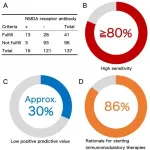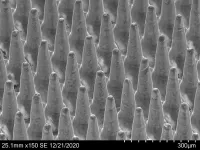(Press-News.org) Two recent papers from Hungarian researchers highlight the so far underrated relevance of pet dog biobanking in molecular research and introduce their initiative to make pioneering steps in this field. The Hungarian Canine Brain and Tissue Bank (CBTB) was established by the research team of the Senior Family Dog Project in 2017, following the examples of human tissue banks. In a recent paper, the team reports findings, which would not have been possible without the CBTB, and may augment further progress in dog aging and biomarker research.
Even though dogs have a much shorter average lifespan than humans, the aging path of the two species has remarkable similarities. Hence our best friends have attracted the attention of aging researchers. Most importantly, dogs tend to develop similar age-related diseases as humans do, including dementia, which is not typical for most other animal species. However, not every human or dog is affected by age-related ailments to the same extent. The ability to foresee the individual tendencies and provide interventions, which can shift aging to a healthier track, is the holy grail of aging research. The fact that dogs mirror human aging in many aspects makes them highly promising preclinical models to test interventions and understand the factors that determine aging. These goals, however, require a deeper insight into the microscopic levels of canine aging as well.
As stated in the recent review paper from the Senior Family Dog Project at the Department of Ethology, Eötvös Loránd University, dog biobanks would represent a valuable source of tissues and other biological materials, which could not be gathered for scientific purposes in any other way. "Medical research often relies on laboratory dogs, but keeping them to study natural aging would be time-consuming, expensive and ethically debatable." - told Dr. Sára Sándor, geneticist, first author of the review published in the journal GeroScience.
Dog biobanks, which collect and store samples from pet dogs, which lived with their owners until being euthanized for medical reasons or old age, may provide valuable support to dog research without the need to include more laboratory animals. "Pet dogs represent various breeds and live together with their owners. Therefore, we can grasp the effects of lifestyle and environmental stressors on aging and dementia in dogs like in no other model animal." - told Dr. Enik? Kubinyi, the principal investigator of the research group. "When we started to study the aging of hundreds of old dogs due to a European Research Council Starting Grant, we realized that during the project, many of these dogs would, sadly, pass away due to natural causes. We could ask the owners whether they would further support research by offering the body of their deceased dogs, we thought. Linking behavior, pet-keeping conditions, and molecular data would result in a unique biobank. We were relieved and very grateful that many owners said yes. Luckily, we met a committed and highly knowledgeable veterinary anatomist, Dr. Kálmán Czeibert, who helped us to establish the Canine Brain and Tissue Bank".
Creating and managing a pet dog biobank holds several challenges, which have to be addressed appropriately, - as discussed in the review paper. Some of these issues, like protocol optimization and communicating the goals in the public media, are shared by human biobanks, which, in contrast to dog biobanks, have a vast literature of protocol development and experiences.
"The bank currently keeps 130 dog brains and other tissues. Besides continuously upgrading our protocols, we conduct our own studies and are open to sharing the samples with research groups from all over the world." - adds Dr. Czeibert.
The CBTB research team first delved into actual molecular research by measuring the amount of protein-coding RNA molecules - termed gene expression - in canine tissues collected by the CBTB. RNA molecules are very sensitive and may degrade soon after the animal's death, making an especial relevance for the CBTB, where tissues can be stabilized only a few hours following the euthanasia of animals. The specific target of this study, published in Frontiers in Veterinary Science, was the cyclin-dependent kinase inhibitor 2A or, shortly, CDKN2A gene. This gene has been proposed as a powerful aging biomarker in humans because it shows an increased expression - a higher number of RNA molecules - in several human tissues with age. This correlation is exceptionally high in the brain tissue of older people affected by dementia. Finding such biomarkers, which can signal the onset of some age-related diseases before actual symptoms take place, is crucial for clinical applications in both dogs and humans.
The researchers examined brain, skeletal muscle, and skin tissue from the donated dogs Following human studies. The team found that older dogs', on average, had more CKDN2A mRNA in their brains and muscles than younger dogs, indicating a positive correlation between CDKN2A expression and age - however, they have not found a similar correlation in the skin. These results, even the inconsistency between tissues, matched previous human findings. The scientists were also curious about how CDKN2A behaved in blood obtained from live animals, as this question would have direct implications for clinical applications. As a first step, they tested 15 border collies and found a moderate, positive correlation with age. "This less pronounced correlation means that further research will be required to validate whether CDKN2A could suffice as a blood-borne biomarker for clinical application in dogs." - added Dr. Sándor. "However, the robust correlation in the brain shows apparent promises for comparative dementia research because it suggests that similar cellular senescence mechanisms contribute to brain aging in dogs and humans."
Hence, it seems that our canine companions will become our best friends in aging research as well.
INFORMATION:
Published recently, and more important paper:
Review article: Sándor, S., Czeibert, K., Salamon, A., & Kubinyi, E. (2021). Man's Best Friend in Life and Death: Scientific Perspectives and Challenges of Dog Brain Banking. GeroScience, May 10, 2021. https://doi.org/10.1007/s11357-021-00373-7. https://link.springer.com/article/10.1007/s11357-021-00373-7
Research article: Sándor, S., Tátrai, K., Czeibert, K., Egyed, B., & Kubinyi, E. (2021). CDKN2A gene expression as a potential aging biomarker in dogs. Frontiers in Veterinary Science, 8, 348. https://doi.org/10.3389/fvets.2021.660435
https://www.frontiersin.org/articles/10.3389/fvets.2021.660435/abstract
Clinicians and scientists have long observed that cells in overstressed hearts have high levels of the simple sugar O-GlcNAc modifying thousands of proteins within cells. Now, researchers at Johns Hopkins Medicine have found evidence in mouse experiments that these excess sugars could well be a cause, not merely a consequence or marker of heart failure.
Their research found that elevated levels of O-GlcNAc made mice more prone to heart failure, but lowering levels of O-GlcNAc restored the animals' risk of death and heart function to normal. Together, the investigators say, the new findings, described online in the April ...
In a study conducted by researchers at Hospital for Special Surgery (HSS), cumulative opioid use was reduced by 30% in a patient group that received duloxetine after total knee arthroplasty (TKA) compared with patients who received placebo. Patients who received duloxetine also reported higher pain management satisfaction and less pain interference with mood, walking, normal sleep, and work activities. These findings were presented at the 2021 Spring American Society of Regional Anesthesia and Pain Medicine (ASRA) Annual Meeting.1
Studies have demonstrated that many patients report joint pain two weeks after ...
Millions of people suffer from psoriasis, a chronic, autoimmune disorder that causes scaly patches on the skin and often precedes psoriatic arthritis. While no cure exists, treatments range from topical creams to injected medications that block inflammation. To improve treatment options, scientists need to better understand the dysregulation of the immune system that leads to these lesions.
Using advanced computational genomic analysis of immune cells from mouse models, a researcher at the Pritzker School of Molecular Engineering (PME) at the University of Chicago and her collaborators ...
COLUMBIA, Mo. - When Ram Raghavan heard from a former colleague at the Centers for Disease Control and Prevention that a 7-year-old girl had died from Rocky Mountain spotted fever as the result of a tick bite, he thought of his own daughter, also 7 years old at the time, and the potentially fatal danger posed to vulnerable populations by tick-borne diseases.
Now a professor at the University of Missouri College of Veterinary Medicine and School of Health Professions, Raghavan is an epidemiologist studying how ticks, mosquitos and other arthropods spread disease that impact people, pets and livestock over time in various geographical regions.
In a recent study, the most comprehensive of its kind in the Midwest region of the United States, Raghavan and former graduate ...
Anti-NMDA receptor (NMDAR) encephalitis was first reported to develop in female young adults with ovarian teratoma. However, another study with a larger cohort reported that more than one-third of all patients with anti-NMDAR encephalitis were aged under 18 years, suggesting that this encephalitis might be more common in children than originally expected.
A clinical diagnostic approach to autoimmune encephalitis was proposed in 2016, and included diagnostic criteria for probable and definite anti-NMDAR encephalitis. For a diagnosis of probable anti-NMDAR encephalitis, the criteria require rapid onset ( END ...
Tokyo, Japan - Materials in a glassy state are everywhere in our lives and have contributed to humanity for many years. Today, they play a critical role in various technologies, including optical fibers. Although we believe that glass is highly stable, it sometimes crystallizes, resulting in loss of transparency and isotropy, essential characteristics of glass, which has been a significant problem in industrial applications. The reason why crystallization occurs in a solid-state with almost no molecular movement has been a great mystery. Its understanding may help to prevent or optimize crystal growth at deep supercooling.
In a study recently published in Nature Materials, researchers ...
A dengue virus vaccine candidate has passed an important milestone, with promising results in animal model testing providing hope to the 390 million people infected every year.
The University of Queensland-developed vaccine candidate, applied to the skin via the high-density microarray patch (HD-MAP), has produced a protective immune response in dengue-infected mice.
UQ PhD candidate Jovin Choo said the result could lead to a readily administered vaccine that could help halt the devastation of dengue fever globally.
"Dengue is the most significant mosquito-borne viral disease in the world's ...
LOS ALAMOS, N.M., May 12, 2021--A new theorem from the field of quantum machine learning has poked a major hole in the accepted understanding about information scrambling.
"Our theorem implies that we are not going to be able to use quantum machine learning to learn typical random or chaotic processes, such as black holes. In this sense, it places a fundamental limit on the learnability of unknown processes," said Zoe Holmes, a post-doc at Los Alamos National Laboratory and coauthor of the paper describing the work published today in Physical Review Letters.
"Thankfully, because most physically interesting processes are sufficiently simple or structured so that they do not resemble ...
A new study, by researchers from Simon Fraser University and the Department of Fisheries and Oceans, reveals the trade-offs of fish biodiversity--its costs and benefits to mixed-stock fisheries--and points to a potential way to harness the benefits while avoiding costs to fishery performance.
Many Pacific salmon fisheries catch fish that come from multiple stocks (management units), often representing locally-adapted populations, in so-called mixed-stock fisheries. Fish are intercepted in the ocean as they migrate along the coast, returning to different rivers to spawn.
The study used computer models of hypothetical fisheries and case studies of three actual sockeye salmon fisheries, including BC's Fraser River fishery, to explore how fish biodiversity within mixed-stock ...
PASADENA, Calif. -- Among cancer patients with health coverage in Southern California, those who were diagnosed and treated at Kaiser Permanente, an integrated health care organization, had better survival rates, especially Black and Latino patients, according to Kaiser Permanente research published in The American Journal of Managed Care.
"Kaiser Permanente is committed to finding and addressing health care inequities," said the study's senior author, Reina Haque, PhD, a cancer epidemiologist in the Kaiser Permanente Southern California Department of Research & Evaluation. "We investigated survival among insured patients with cancer ...





